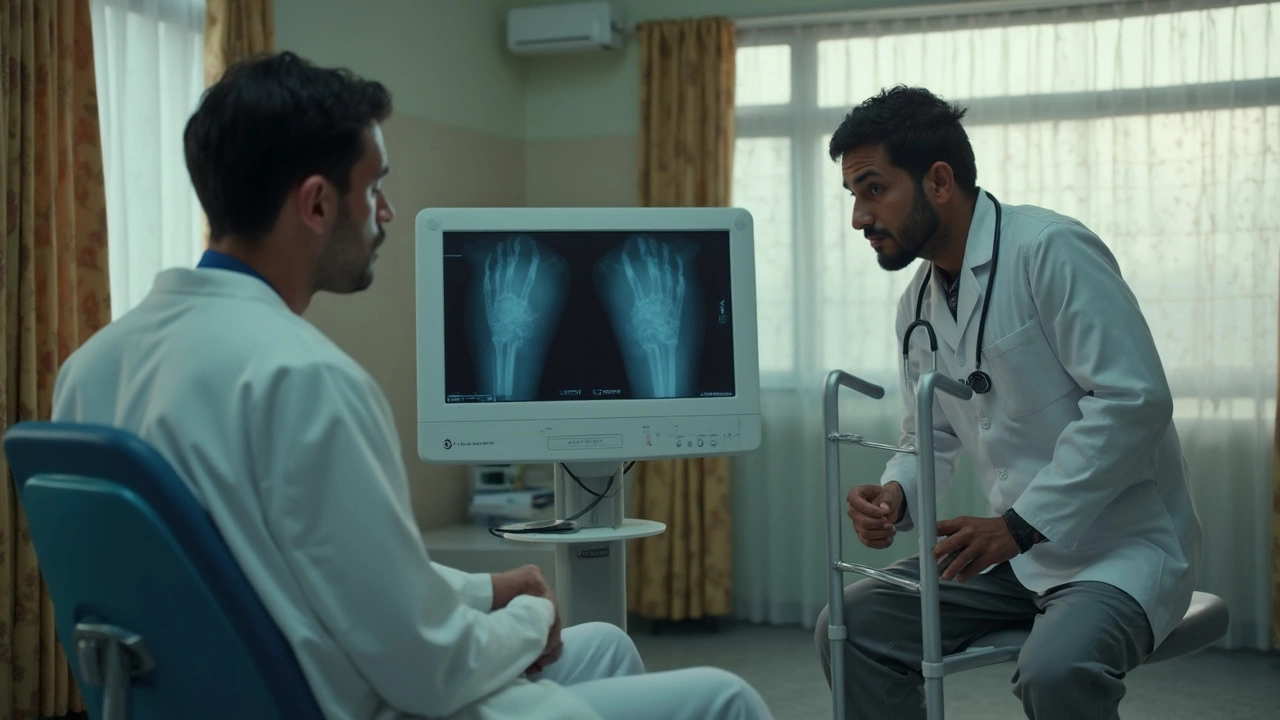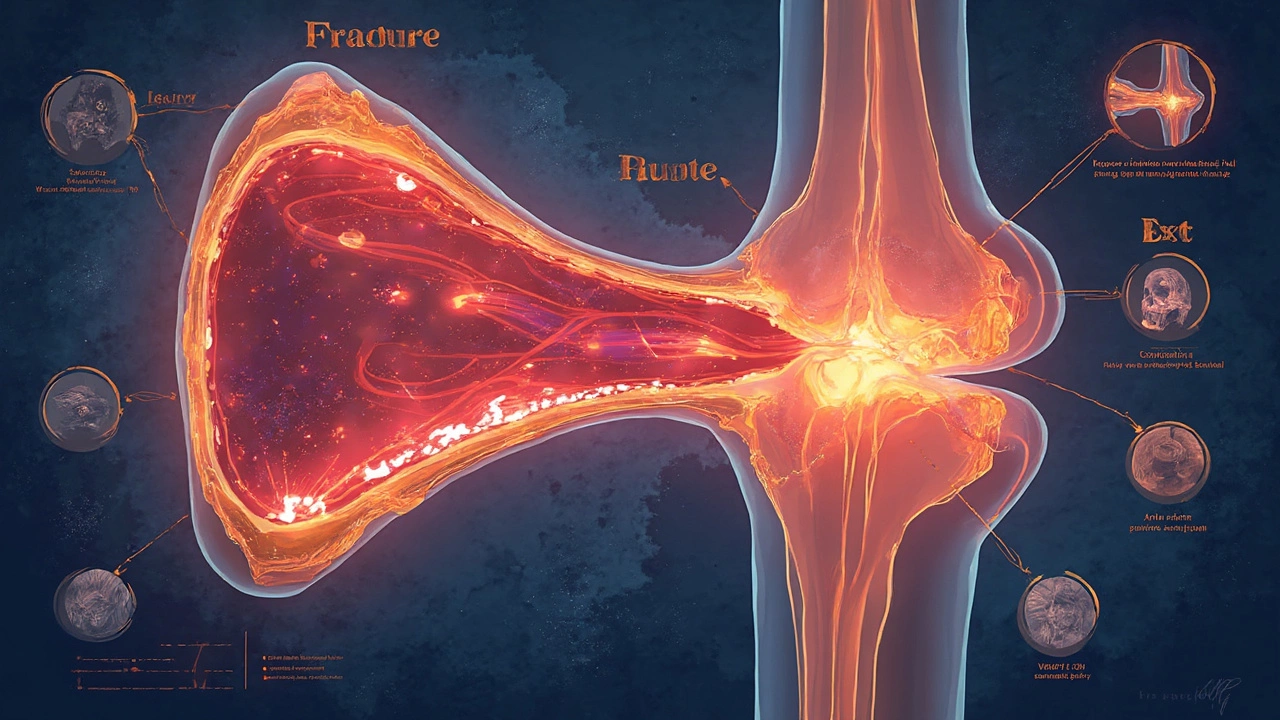
Breaking a bone hurts, but some breaks are way harder to bounce back from than others. If you ask any orthopedic doctor which bone is the hardest to heal, they’ll probably say the femur—the thigh bone. You might be thinking, “Isn’t that the biggest bone?” Exactly, and that’s actually part of the problem.
The femur takes a lot of stress every day. Think about walking, running, or just standing up—your whole weight is pressing on it every second. That means when it snaps, it’s rarely a simple break, and the recovery feels endless for many people.
It’s not just the size. The femur has thick muscle all around it. Sometimes the broken pieces get pulled apart, or the bone shifts, making healing trickier. No wonder doctors don’t exactly celebrate when they see a patient with a femur fracture in the ER.
- Meet the Femur: The Body's Trouble Bone
- Why the Femur Breaks Heal So Slowly
- Common Challenges During Recovery
- Tips to Speed Up Femur Healing
- When Things Go Wrong: Complications to Watch
Meet the Femur: The Body's Trouble Bone
If you had to pick a bone for a heavyweight championship, the femur would win hands down. It’s the longest and strongest bone in your body, running all the way from your hip to your knee. This thick, tough bone supports the kind of pressure that would snap most others—but that strength is exactly what makes it so tough to heal when it finally does break.
Most femur fractures don’t just happen from a simple fall. Think high-speed car crashes, major sports injuries, or serious falls. In fact, over 90% of femur breaks are due to big trauma events. It takes a ton of force to bust through it, which is why when the femur is broken, there are usually other injuries too. That means recovery isn’t just about the bone, but about the whole leg—and sometimes the whole body.
So why is the femur the hardest bone to heal? There are a few reasons:
- It’s surrounded by powerful muscles that can yank broken pieces out of alignment.
- It carries your body weight, so you usually can’t just "walk it off" like a sprained ankle.
- The blood supply is critical for healing, and breaking the femur can mess with those vessels.
Here’s something you might not know: children’s femur fractures heal faster, sometimes in just a few weeks, while adults can be stuck waiting for months. The healing time after a femur fracture usually looks like this:
| Age Group | Healing Time (Typical) |
|---|---|
| Children | 4-8 weeks |
| Teens | 8-12 weeks |
| Adults | 12-24 weeks |
Doctors often have to use metal rods, screws, or plates to put the femur back together. There’s no light-duty cast like you see for a wrist. It’s big hardware for a big job. That’s why the hardest bone to heal usually means a hospital stay, surgery, tons of follow-ups, and a whole lot of patience.
Why the Femur Breaks Heal So Slowly
If you’ve ever googled “hardest bone to heal,” the femur almost always pops up. But why does it take so long? First, the femur is the thickest and strongest bone in the body, so when it breaks, it’s usually from a high-impact fall, car crash, or sports injury—not something minor. That type of trauma messes up not just the bone, but the muscle, tissue, and sometimes even the blood supply around it.
One big problem with femur breaks? The two ends rarely line up perfectly after a break, because all those big thigh muscles actually pull the pieces apart. This makes the injury unstable and hinders healing. That’s why surgeons often put in metal rods, screws, or plates to keep everything in place for months. And even then, healing can drag on.
Another reason for slow healing is blood flow. Even though the femur has good blood supply, a major break can seriously mess that up. Good blood flow is like fuel for healing—when it gets disrupted, recovery slows down a lot. Plus, older adults or folks with conditions like diabetes or osteoporosis usually take even longer to heal.
| Average Healing Times | Notes |
|---|---|
| Children | 8-12 weeks |
| Adults (18-60) | 12-16 weeks |
| Seniors (60+) | 5-6 months or more |
Then there’s the day-to-day stuff. You can’t just walk around with a broken femur. Most people need crutches, walkers, or wheelchairs. That means muscles can get weaker, joints stiffen up, and it’s easy to lose confidence in basic movements.
All this makes it clear why the femur fracture is nobody’s idea of a minor injury. It’s tough for the patient, stressful for families, and pushes even the best orthopedic hospital teams to their limits.

Common Challenges During Recovery
If you or someone you care about has a femur fracture, you've probably noticed that the recovery road is anything but smooth. Healing this hardest bone to heal comes with more roadblocks than most folks expect.
For starters, the femur supports the whole body. So, unlike an arm, you can't totally avoid using it, even with crutches. Early on, most people deal with serious pain, muscle weakness, and it’s pretty normal to feel super tired. Bed rest might sound great, but the truth is, you lose muscle strength fast if you can’t move that leg.
Next up: keeping the bone in the right spot. Even with plates, screws, or metal rods, bones might shift—especially if you start walking too early. Doctors will take a lot of X-rays to double-check everything is healing straight. If the bone doesn’t line up, you could end up needing more surgery.
Another common snag is blood clots. Because you're not moving around much at first, clots can form in your legs. That’s why doctors might give you blood thinners or those super-stylish compression socks. Not fun—but skipping them is risky.
| Common Complication | How Often? |
|---|---|
| Malunion (bone heals crooked) | 10-20% |
| Blood clots | 1-3 out of 100 patients |
| Infection (after surgery) | 2-5% |
| Hardware failure | Up to 5% |
Regaining normal movement is a pain point, literally. Joints can get stiff fast, and muscles shrink while you're off your feet. Most people need months of physiotherapy to even think about ditching the crutches. Sticking with the exercises, even when it hurts, is huge for a decent recovery.
And honestly, the mental part is just as tough. People can get frustrated, anxious, or even down in the dumps because they aren't healing as quick as they'd hoped. If you're feeling like this, it helps to know it’s common. Talking to a support group, family, or your doctor makes a big difference.
Tips to Speed Up Femur Healing
Waiting for a femur fracture to heal can feel like forever, but you can do a few things to help the process along. Here’s what orthopedic experts always recommend—and some small changes that make a real difference.
- Follow your doctor’s instructions, religiously. Missing a follow-up or ignoring movement guidelines can set you back. If the doctor says no weight on the leg—don’t argue. Let it rest.
- Stay on top of nutrition. Your bones need fuel to heal, and that means protein, calcium, and vitamin D. Think eggs, yogurt, spinach, almonds, or fortified cereals. Sometimes, doctors will even suggest vitamin supplements to cover all your bases.
- Don’t skip physical therapy. It can look boring, but those stretches and gentle moves keep your muscles alive and teach your body how to walk right again. The sooner you get back strength and mobility, the faster your recovery.
- Stay active (as much as allowed). If you can’t walk, try upper body exercises or simple movements to help with blood flow and stop muscle wasting. Keeping the rest of your body fit helps your whole system bounce back.
- Avoid smoking and alcohol. Both slow bone healing big time. For example, studies show smokers heal 40% slower from a femur fracture. Alcohol can mess with nutrient absorption, weakening your bones when you need them strong.
- Watch for signs of trouble. If swelling, pain, or redness suddenly gets worse, call your doctor. Early treatment means quicker healing if there’s an infection or complication.
| Healing Step | Timeframe |
|---|---|
| Initial bone repair | 6-12 weeks |
| Physical therapy | 12-20 weeks |
| Return to basic activities | 4-6 months |
| Full recovery (heavy sports) | 6-12 months |
*Every case is different. Factors like age, health, and the severity of the femur fracture really affect how quickly you get better.
If you want to speed up your healing, be patient but stay proactive. Check-ups feel repetitive, but skipping them risks undoing everything. And yes, eat your veggies—your leg will thank you for it.

When Things Go Wrong: Complications to Watch
Femur fractures are tough, but what if things don’t heal as planned? A broken femur can develop several complications, which is why follow-ups with your orthopedic team matter way more than you’d think.
First up, there’s something called non-union, which means the bone simply refuses to knit back together. That’s one of the biggest reasons why the femur is known as the hardest bone to heal. When this happens, doctors might try bone stimulators, extra surgeries, or even a bone graft. Unions can take up to six months—and sometimes even longer if you smoke, have diabetes, or don’t stick with your rehab.
Another risk is malunion. Here, the bone heals, but does it in the wrong way. You’re left with a leg that’s a little wonky—so walking gets tricky, and pain sticks around. Sometimes you’ll need another round of surgery to get things lined up again.
Infections are a big worry too, especially with open breaks or surgeries involving rods and screws. Signs like high fever, redness, and swelling near the break mean you should see your doctor ASAP. In rare cases—less than 5% according to orthopedic studies—infections can slow healing and lead to more hospital time.
Here’s a quick look at the most common complications and their frequency:
| Complication | How Often It Happens |
|---|---|
| Non-Union | 5-10% |
| Malunion | 7-15% |
| Infection after Surgery | 1-5% |
| Nerve/Vessel Injury | Less than 1% |
Blood clots, or deep vein thrombosis (DVT), can also pop up After a femur fracture or surgery. Swollen, painful legs or shortness of breath shouldn’t be ignored—it’s a medical emergency. Some doctors put patients on blood thinners for a few weeks just to be safe.
- Make sure you keep moving as soon as your doctor says it’s okay—this cuts down clot risks.
- Watch for any changes at the wound or weird pain in your calves.
- If you notice anything unusual, reach out to your orthopedic team without delay.
Bottom line? The femur is a real troublemaker when it comes to healing. Spotting problems early gives you a better shot at a smooth recovery—and keeps you out of the hospital for repeat visits.

Write a comment